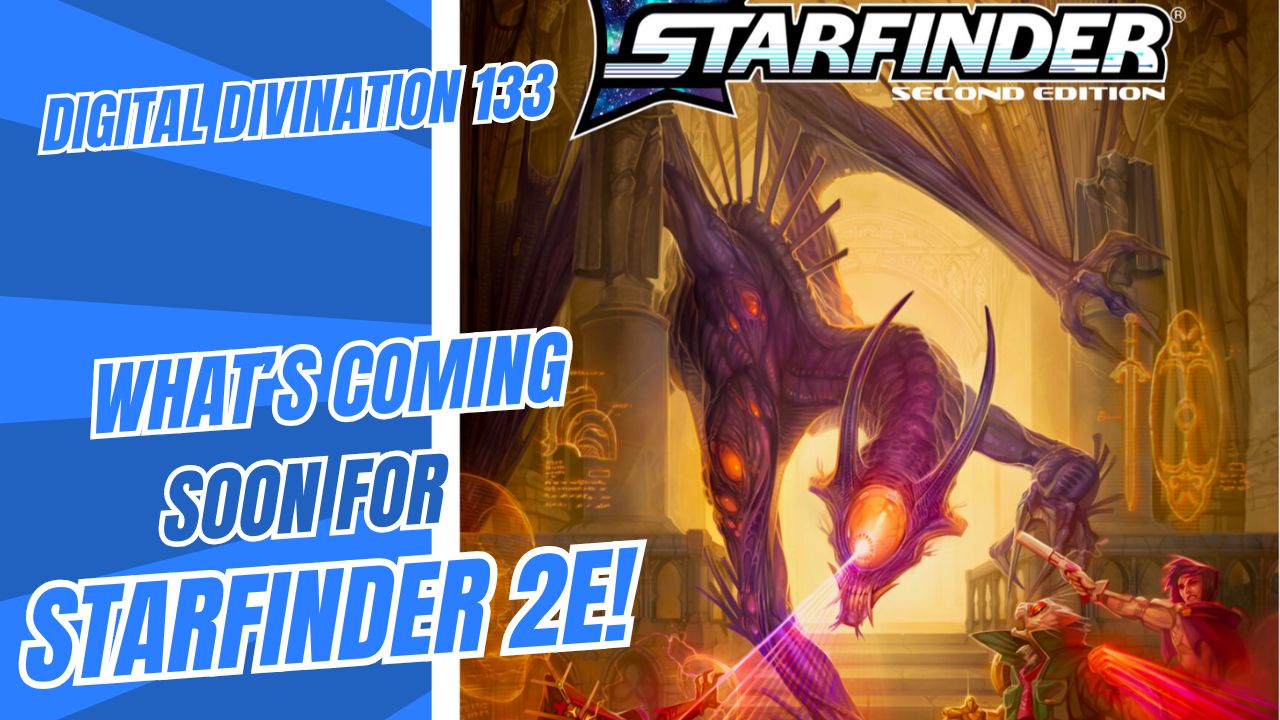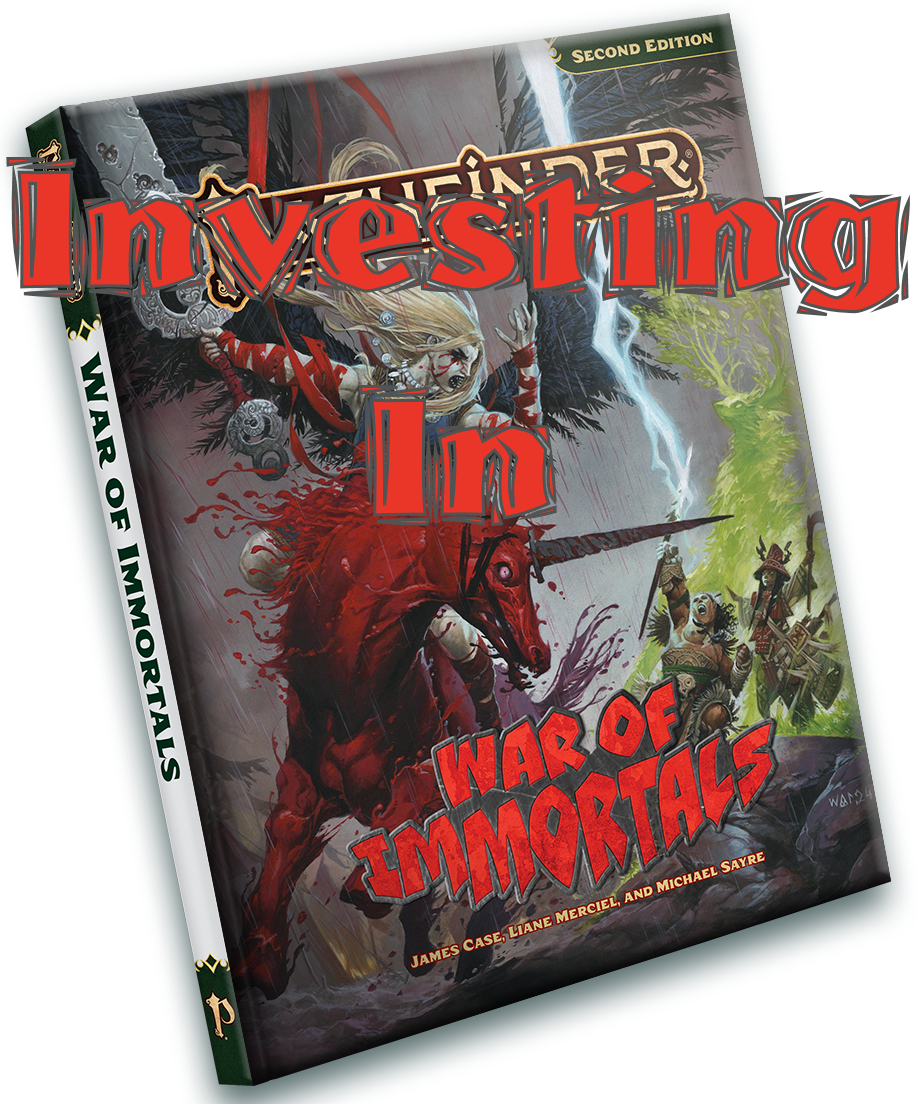Items of such mythical standard that their power develops gradually as their wielders bond with them. Many fictional characters are as identifiable as their trademark weapon, if not overshadowed by it. That alluring premise is translated into game terms in the Weapons of Legacy (WoL) Dungeons and Dragons sourcebook, entirely dedicated to legacy items that improve or gain new abilities as their owner advances. But are they just better magic items or a new take on artifacts?
At a Glance
The cover certainly gets the point across. A variety of ornate weapons, mostly swords, mounted behind what appears to be a shield fashioned in the likeness of a red dragon. It’s a nice image. Except that none of the weapons on the cover are featured in WoL. Most of them are quite ordinary when compared to the actual Legacy Items inside. I could understand if the artist went with his own weapon designs for a colour scheme, as most weapons are the same silver with leather brown handles and red jewels that compliment the red dragon shield. But there’s one wooden weapon, a thorn-headed club with blue and green jewels entwined between roots, that throws out that theory. In the end, not using examples from inside the book is less a complaint than an oddity that I obsess over.
The interior artwork is a whole different story. Many pictures outside of Chapter 3: Legacy Items, feature characters using or interacting with the items featured in the book. Although neither the blazing hammer Tordek wields nor the lich’s smoking skull quarterstaff that he is shattering are listed weapons of legacy, the picture brings to life the uberepic battle so well, it can be forgiven.
Most of the weapons are drawn to stand out of the pack. A couple are lower quality illustrations, but the good definitely outweighs the bad here. The gruesome Bloodcrier’s Hammer, the mid-morph Infultrator, and the just gorgeous Scales of Balance please the eye every time.
Highlights
Interesting Histories
There are only 49 Legacy Items in this 222 page book. Why so few? Because each is given four pages, usually a page of which is dedicated to the history of the weapon. Which makes perfect sense. These aren’t Weapons of Great Power, they’re Weapons of Legacy, and the story behind them ties into their abilities and how you unlock them.
These interesting stories vary quite a bit from one weapon to another and are well thought out. Some present basic information and as background, offering more details the higher the Knowledge: History roll. Others start the story with who the most famous wielder was and what was famous about the weapon, then explain why the weapon was famous. Granted, some legacies are far less Earth-shattering than others.
Player Options
Legacy feats that work like metamagic feats for Legacy abilities. Spells that can enhance or suppress the Legacy abilities of allies or enemies. These are thoughtful additions to the book that expand the potential of playing a character with a Legacy Item.
New Material for Old Options
This is such a touchy subject. When a new sourcebook is released, should it expand upon material introduced outside the Core Rulebooks? If not, a player that enjoys Psionics or a group that plays at Epic levels will be forever cornered into the limited material currently available. And there will be nothing new to potentially convince a player to give a less mainstream class from the Complete series another look. If so, those that know what they like and play with specific material are buying a whole sourcebook with the knowledge they’ll never use a chunk of what’s in it.
I can sympathize with both sides. I know I appreciate when obscure classes, races, and rules are explored fresh, or even acknowledged. Something as simple as a raptoran (Races of the Wild) or a warlock (Complete Arcane) showing up in a picture or example in an otherwise unrelated sourcebook is enough to make me smile. However, I vehemently oppose any mention of D&D campaign settings leaking into my campaign-neutral sourcebooks.
In WoL, there are Psionic powers that essentially mimic the spells mentioned earlier. There is also one Legacy Item, Mau-Jehe specifically for soul knives (Expanded Psionics Handbook) and another that would be ideal for halfling outriders (Complete Warrior). Finally, there is advice and rules for bringing Weapons of Legacy to Epic gaming. In all, this material takes up less than ten pages. Hopefully that’s not too much wasted paper for those with no use for such material.
Low Points
Undefined Rules
This is as big a problem as a book can have. Basic rules, like which abilities are least legacy abilities, which are lesser legacy abilities, and which are greater legacy abilities, are left out of the book entirely. Because Legacy items have no unusual abilities before 5th level, a character must be 11th level to unlock lesser abilities and 17th level to unlock greater abilities, it can be assumed that least legacy abilities are 5th-10th level, lesser 11th-16th, and greater 17th-20th. However, different interpretations of implied rules have been freezing gaming sessions since 1974.
Furthermore, each legacy item has legacy ritual that must be performed, which includes a gold points cost. For example, to gain the bonus feat Lesser Legacy Ability (Exordius) and unlock Exordius’ lesser legacy abilities (whichever they may be), “you are required to seal yourself in complete and total darkness for 24 hours.” It’s cost? 3000gp.Where does this money go? Is it left in the darkness? That explains why dungeons have so much random treasure. Maybe it just dematerializes? Is that the cost of renting a room and having a necromancer friend cast Permanent Darkness? Ultimately it doesn’t matter to your character, who loses the 3000gp regardless, but you never know when such information might prove useful. At least when a wizard or sorcerer summons a familiar, it explicitly says the ritual “uses up magical materials that cost 100gp”.
You Got Fluff in my Crunch!
Many of the rituals are not conducive to actual play. The most popular legacy ritual is winning one-on-one combat against a monster of equal or greater CR. This means the rest of the party must sit out while one player has solo fun in an encounter they may very well might lose, either having to repeat the ritual at a later time or dying.
There are also severe penalties to advance these weapons. PCs wielding legacy items can expect to lose hit points, skill points, or spell slots, and take penalties to their base attack and saves, on top of the expensive rituals. It isn’t long before the benefits of the weapon of legacy aren’t overshadowed by a good prestige class and a custom-made magic items.
Drowning in Sample Encounters
Each item has a sample encounter outlining a situation in which the PCs could come across legacy items. Instead of giving a few examples or even a dozen examples, it gives forty-nine sample encounters in the EL 5-7 range. This space would have been better used for rule clarifications or more legacy items.
Caput Mortuum
Normally I limit myself to three highlights and three low points, but I can’t let my hatred of one of the Weapons of Legacy go unmentioned. There is a scythe of legacy called Caput Mortuum. My brain bleeds a little every time I think the name. Caput? As in “There’s nothing I can do to fix your engine, lady. She’s caput”. And that’s not bad enough, they had to add a hip spelling of mortem to make sure we know that this particular scythe is extra killy.
Stupid name aside, there’s the picture. It’s well drawn, very realistically rendered, with only one thing separating it from a regular scythe. A red circle with three red dots inside. It’s described as a glyphs in a V, but all I see is a surprise emoticon. I guess he’s shocked at how many people the scythe’s made go caput.
Worse of all, it has the most boring progression. It starts as a +1 vicious scythe at fifth level and ends up a +5 unholy vicious wounding scythe by the end. Anyone with some gold can create this weapon, save for the one special ability the weapon gets, which is fortunately pretty cool. For every creature you kill with Caput Mortuum, you gain their soul as a special unseen servent. Presumably this only happens when you kill creatures with souls, but, as is the trend in WoL, it doesn’t specify.
Juicy Bits
Coral’s Bite has a great backstory about an aquatic elf hero of the people that no one knew was a shape changer who assume the form (unless you succeed at a Knowledge: History DC 25 check). He became so assimilated into the culture that he forgot how to change back.
Hammer of the Witches is a warhammer used by a rogue band of worshippers of Pelor to crush magic-using heathens. It’s the first time Pelor’s been presented as anything but the most benevolent of gods and, in my opinion, the first time the sun god is the least bit interesting.
Personal Experience
Weapons of Legacy wooed me so much I based an entire campaign around collecting them. Very early on, I began making house rules to clarify how these items work. By the end of the campaign, the legacy items had taken a back seat.
Overall
The more I got to know this book, the more it felt like an amateur OGL publication. Getting to the good stuff in this sourcebook is like wadding through a one-corridor dungeon with the treasure in sight but so many traps that spring out of nowhere you repeatedly wonder if it’s really worth it.
If You Liked This Book…
The Magic Item Compendium catalogues over a thousand magic items, new and previously published.




Leave a Reply